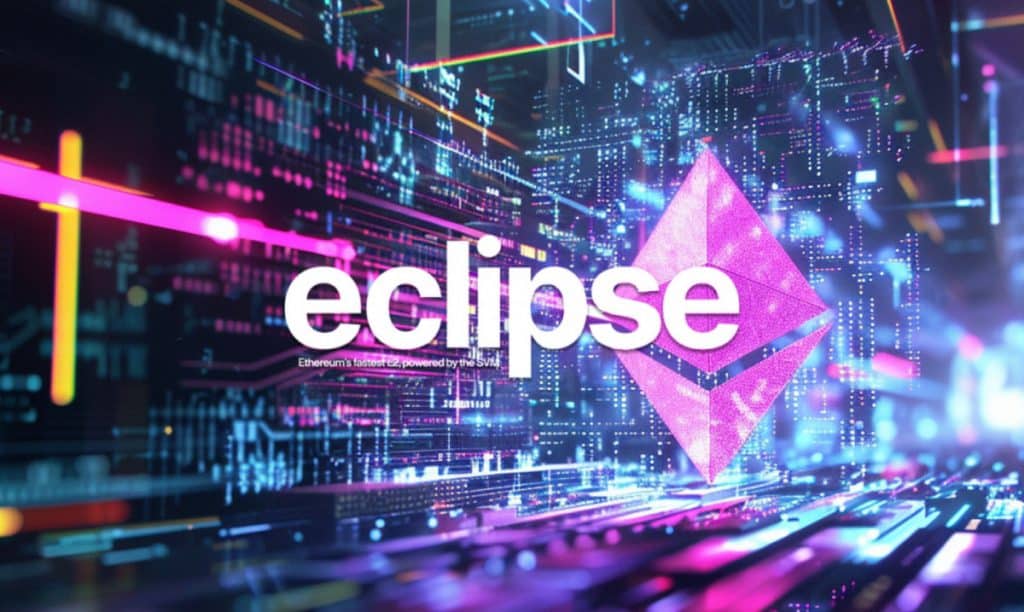Eclipse Raises $50M Funding to Catalyze L2 Blockchain Development Ahead of Mainnet Launch


In Brief
Eclipse raised $50M funding to develop its Ethereum L2 scaling solution utilizing Solana Virtual Machine, gearing up for mainnet launch.

Modular blockchain Eclipse raised $50 million in a Series A funding round led by Placeholder, Hack VC, Polychain Capital, Delphi Digital, Maven 11, DBA, and Fenbushi Capital, with strategic contributions from Flow Traders, GSR, Apollo Global Management, and OKX Ventures.
The new capital injection brings the total funding for Eclipse to $65 million. The company intends to allocate the funds toward advancing project development and gearing up for the mainnet launch.
Eclipse is a customizable rollup provider, offering compatibility with various Layer 1 blockchains. The architecture of Eclipse incorporates the Solana Virtual Machine (SVM) for execution, the modular data availability network Celestia for ensuring data availability, and Ethereum for settlement and consensus.
“Eclipse integrates the high-performance SVM with the deep pools of liquidity on Ethereum while maintaining the hard constraint of verifiability,” said Neel Somani, founder of Eclipse Labs, in a written statement.
The company aims at developing a highly composable Ethereum Layer 2 chain. According to Neel Somani, the goal is to provide Ethereum with a single, scalable, and composable Layer 2 solution capable of addressing 99% of use cases.
Founded in 2022, the company has already introduced a devnet and testnet version of its protocol, attracting various decentralized applications (dApps) to test its infrastructure, including non-fungible token (NFT) marketplace Rarible, oracle infrastructure Pyth Network, and lending protocol Solend. Eclipse plans to launch its mainnet in Q2 of 2024. After the mainnet release, it intends to support hackathons, accelerators, and community events for its users.
Eclipse’s Innovative Approach for Modularity
Blockchain modularity involves the organization of various design layers within a blockchain stack, encompassing execution, settlement, consensus, and data availability. Traditional blockchains such as Bitcoin, Ethereum, and Solana typically perform these functions using the same set of nodes. In contrast, modular blockchains separate these distinct functionalities into specialized layers for enhanced efficiency and flexibility.
“There are numerous theoretical solutions and funded infrastructure aimed at addressing liquidity fragmentation in the foreseeable future. However, our perspective emphasizes the abundance of readily available opportunities at the execution layer, which we aim to integrate for an enhanced user experience on Ethereum. Eclipse is designed to stand out as the most performant Layer 2,” said Neel Somani, the founder of Eclipse.
Even with the Dencun upgrade featuring EIP-4844, or proto-danksharding, the company intends to use Celestia for data availability. Eclipse may potentially publish specific data, such as state differentials, to Ethereum following full danksharding. However, publishing all transactions to the data availability layer, even for zero-knowledge rollups, offers advantages. This strategy ensures transparency, allowing swift verification for anyone to detect potential tampering or compromise in a zero-knowledge proof system.
Eclipse’s recent investment and commitment to innovation position it as a critical player in the blockchain space, emphasizing its intention to revolutionize the landscape of Layer 2 solutions.
Disclaimer
In line with the Trust Project guidelines, please note that the information provided on this page is not intended to be and should not be interpreted as legal, tax, investment, financial, or any other form of advice. It is important to only invest what you can afford to lose and to seek independent financial advice if you have any doubts. For further information, we suggest referring to the terms and conditions as well as the help and support pages provided by the issuer or advertiser. MetaversePost is committed to accurate, unbiased reporting, but market conditions are subject to change without notice.About The Author
Alisa is a reporter for the Metaverse Post. She focuses on investments, AI, metaverse, and everything related to Web3. Alisa has a degree in Business of Art and expertise in Art & Tech. She has developed her passion for journalism through writing for VCs, notable crypto projects, and scientific writing. You can contact her at alisa@mpost.io
More articles

Alisa is a reporter for the Metaverse Post. She focuses on investments, AI, metaverse, and everything related to Web3. Alisa has a degree in Business of Art and expertise in Art & Tech. She has developed her passion for journalism through writing for VCs, notable crypto projects, and scientific writing. You can contact her at alisa@mpost.io






















































